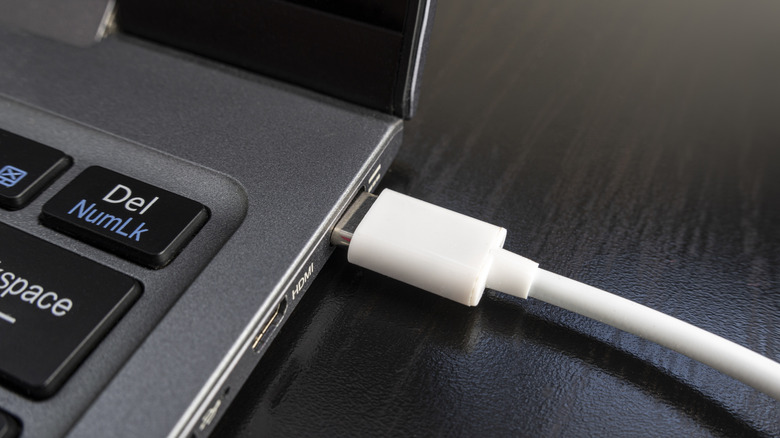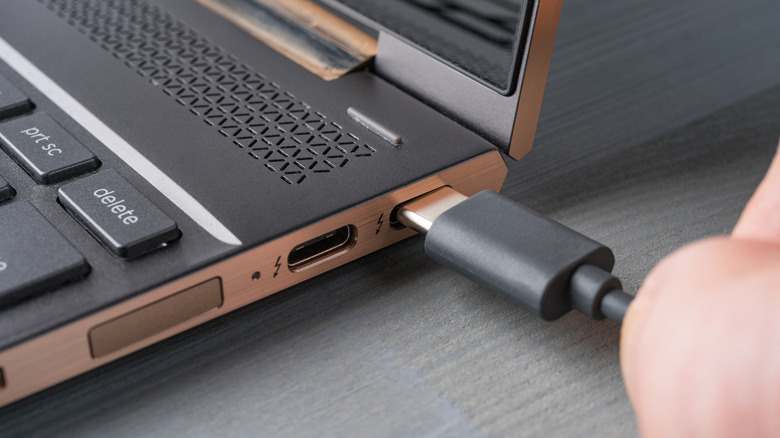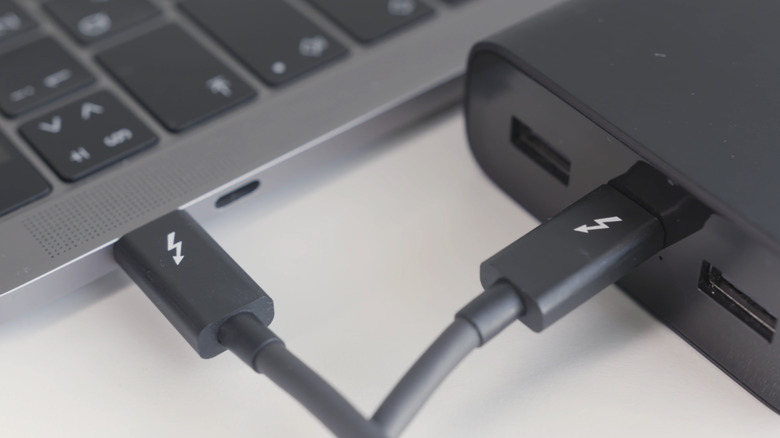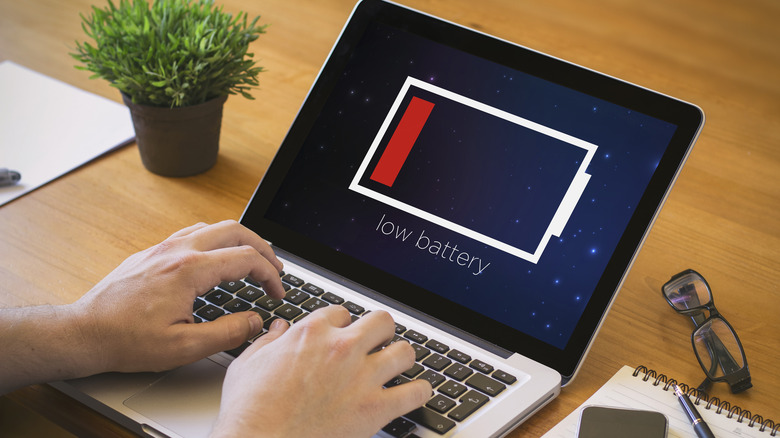Is It Safe To Leave Your Laptop Plugged In All The Time? Here's What We Know
Whether you're getting a new laptop or experiencing an aging battery life in an old one, a question might pop up in your head — is it safe to leave it plugged in at all times? After all, a laptop is only as good as its battery. It doesn't matter what processor it has or whether the screen has a 4K resolution; they're only useful for as long as the battery is. To avoid running out of charge, some users keep their laptops plugged in at all times so that they can still use the device for a few hours if there's an outage.
Most modern-day laptops come with lithium batteries, chemicals devices that can hold and dissipate charge at the required time and rate. The battery is constantly active whenever we use the laptop, whether it is plugged in or not. Laptop batteries have a limited life, measured in charge cycles or the number of times you charge and discharge the battery to its maximum capacity.
This means that one of the most crucial factors determining the overall lifespan of your laptop's battery is how you charge it — whether you keep it plugged in at all times or only charge it as needed.
How long do you charge your laptop?
Let's start with the basics of what happens in your laptop when you leave it plugged in. Typically, your device might end up in one of these three scenarios, depending on the total time you connect them to a charger.
The first scenario is quite the usual, when your laptop runs out of battery or is about to die, and you plug it in to recharge. Now, depending on the battery size and the charging speed, your notebook's battery might take a certain amount of time to reach 100%, ranging from an hour to a couple of hours.
So, naturally, leaving your laptop plugged in for the required time is absolutely safe unless you're using a damaged or incompatible charger that could fry the electrical circuits and leave your device useless — just something to keep in mind.
The second scenario many users might find themselves in is leaving the laptop plugged in for more than required. Not by a few minutes, mind you, but a few hours, like if you leave your device plugged in overnight. Is it safe?
Charging style can make or break the battery's health
Yes, most modern-day machines are smart enough to stop drawing power from the adapter and cut the supply to the battery cells, which prevents overcharging. However, constant connection with a power outlet could lead to battery trickle, which is unsuitable for device health.
Yes, the built-in circuit stops accepting power from the charger when the battery reaches 100%, a safety measure to prevent your laptop from exploding or catching fire. However, even when it's not in active use, your notebook loses some charge, and the moment it hits 99%, it begins recharging. This cycle could continue for a while, depending on how long you leave your device plugged in. It keeps the battery under constant load and increases its temperature, which can be very harmful to the laptop's battery.
Constant battery trickle increases the rate at which your battery ages, reducing the time your laptop can function without being connected to a power source. If you want your device to continue to be able to work wirelessly for hours throughout its lifespan, only connect the charger when needed.
Constantly using your laptop on AC power could be a problem
The third and worst scenario is when you never disconnect the power cable from your laptop and use it all day, every day, on AC power. Suppose you replaced your desktop with a laptop, and all your device does is sit in one place throughout the day. It doesn't matter what you use your device for, as it's always plugged in and will most likely remain at a 100% charge, which can cause permanent damage.
Of course, leaving the device plugged in could be much more convenient for you, and it's safe too, but you should know that this rapidly decreases the battery's charge-holding capacity. When you keep your laptop plugged in, the battery doesn't only have to charge itself but power up the other components you might be using at a given point. To accomplish this, it overworks, receiving and redirecting charge simultaneously, heating up more than usual.
Although these things also happen when you leave your laptop plugged in at night, leaving a laptop plugged in throughout the day increases the frequency, taking a toll on the battery and degrading it before the rated charge cycles count. So what can you do to increase the battery's lifespan?
How to increase the lifespan of your laptop's battery
Although battery aging is inevitable, you can keep the aging rate in check by following a few charging and usage tips. If your laptop remains plugged in at all times, you could benefit from setting a battery charge threshold. HP suggests that if you charge your laptop battery to less than 90% instead of 100%, you can improve its "discharge cycle from 300 to even an extra 1000 recharges."
The way to set a charging threshold depends on who made your laptop. Lenovo provides a companion app called Lenovo Vantage that allows you to set when your battery starts and stops charging. Similarly, ASUS laptops have a Maximum Lifespan Mode that limits charging to 60%. Other companies like Dell, MSI, and HP also have a power management setting in place. MacBooks, on the other hand, have the Optimized Battery Charging feature that learns your usage patterns and delays charging to 100%.
For those who rely on their laptop's battery life, using it in power-saving or low-performance mode will help them get the most hours. Taking care of the display sleep timer and using the laptop at lower screen brightness, especially indoors, are a few tips that can help you get the best out of your laptop's battery.




